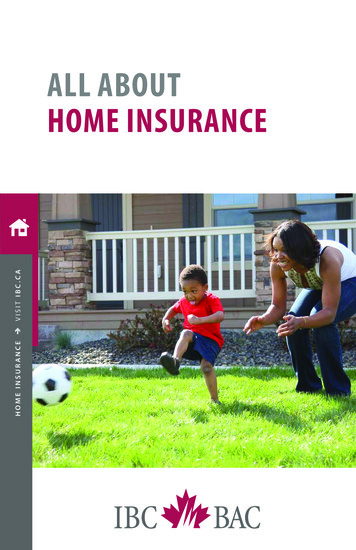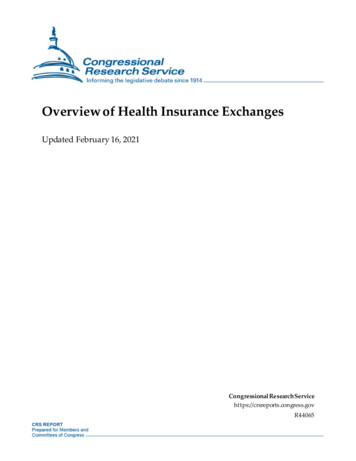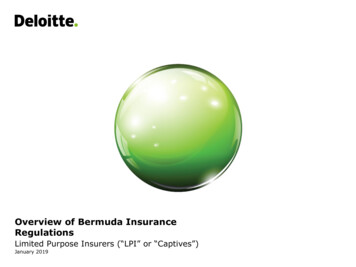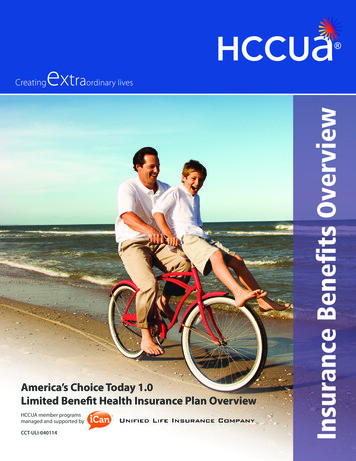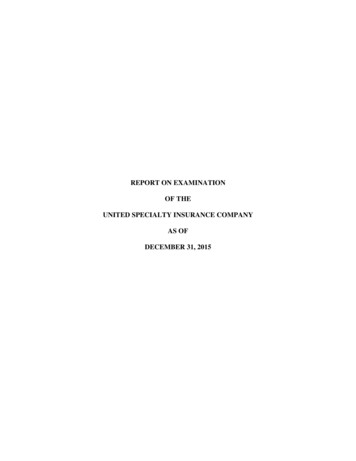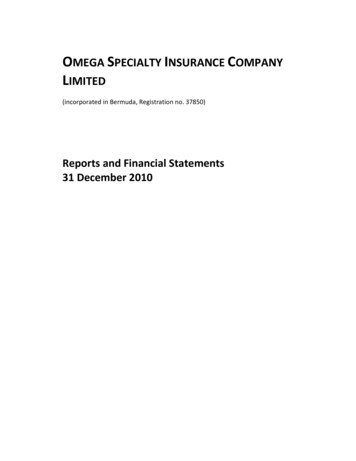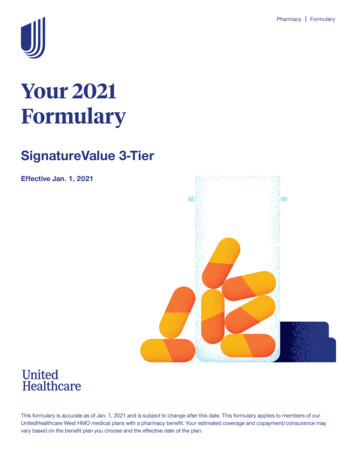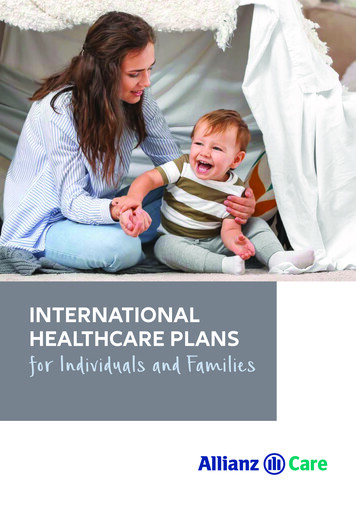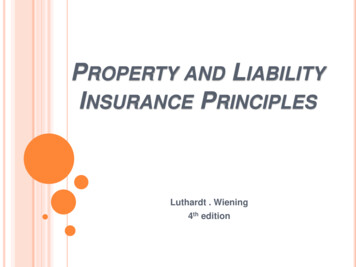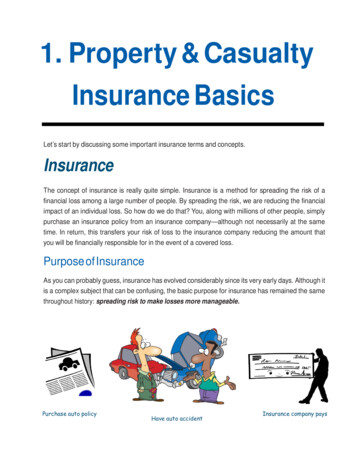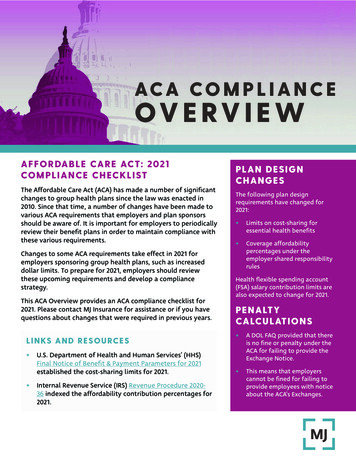
Transcription
ACA CO M P L I A N C EOV E RV I E WA F FO R DA B L E CA R E AC T: 2021CO M P L I A N C E C H EC K L I STThe Affordable Care Act (ACA) has made a number of significantchanges to group health plans since the law was enacted in2010. Since that time, a number of changes have been made tovarious ACA requirements that employers and plan sponsorsshould be aware of. It is important for employers to periodicallyreview their benefit plans in order to maintain compliance withthese various requirements.Changes to some ACA requirements take effect in 2021 foremployers sponsoring group health plans, such as increaseddollar limits. To prepare for 2021, employers should reviewthese upcoming requirements and develop a compliancestrategy.This ACA Overview provides an ACA compliance checklist for2021. Please contact MJ Insurance for assistance or if you havequestions about changes that were required in previous years.L I N KS A N D R E S O U RC E S U.S. Department of Health and Human Services’ (HHS)Final Notice of Benefit & Payment Parameters for 2021established the cost-sharing limits for 2021.Internal Revenue Service (IRS) Revenue Procedure 202036 indexed the affordability contribution percentages for2021.PLAN DESIGNCHANGESThe following plan designrequirements have changed for2021: Limits on cost-sharing foressential health benefits Coverage affordabilitypercentages under theemployer shared responsibilityrulesHealth flexible spending account(FSA) salary contribution limits arealso expected to change for 2021.P E N A LT YCA LC U L AT I O N S A DOL FAQ provided that thereis no fine or penalty under theACA for failing to provide theExchange Notice. This means that employerscannot be fined for failing toprovide employees with noticeabout the ACA’s Exchanges.
ACA CO M P L I A N C E OV E RV I E WPLAN DESIGN CHANGESG R A N D FAT H E R E D P L A N STAT U SA grandfathered plan is one that was already in existence when the ACA was enacted on March 23,2010. If you make certain changes to your plan that go beyond permitted guidelines, your plan is nolonger grandfathered. However, grandfathered status does not automatically expire as of a specificdate. A plan may maintain its grandfathered status as long as no prohibited changes are made.Once a plan relinquishes grandfathered status, it cannot be regained and the plan must comply withadditional reforms under the ACA.Contact MJ Insurance if you have questions about changes you have made, or are considering making,to your plan.R E V I E W YO U R P L A N ’S G R A N D FAT H E R E D STAT U S : If you have a grandfathered plan, determine whether it will maintain its grandfathered statusfor the 2021 plan year. Grandfathered plans are exempt from some of the ACA’s mandates. Agrandfathered plan’s status will affect its compliance obligations from year to year. If your plan will lose its grandfathered status for 2021, confirm that the plan has all of theadditional patient rights and benefits required by the ACA for non-grandfathered plans. Thisincludes, for example, coverage of preventive care without cost-sharing requirements. If your plan will keep its grandfathered status, continue to provide the Notice of GrandfatheredStatus in any plan materials provided to participants and beneficiaries that describe thebenefits provided under the plan (such as the plan’s summary plan description and openenrollment materials). Model language is available.COST - S H A R I N G L I M I TSEffective for plan years beginning on or after Jan. 1, 2014, non-grandfathered health plans are subjectto limits on cost sharing for essential health benefits (EHB). The ACA’s overall annual limit on costsharing (also known as an out-of-pocket maximum) applies for all non-grandfathered group healthplans, whether insured or self-insured. Under the ACA, a health plan’s out-of-pocket maximum for EHBmay not exceed 8,550 for self-only coverage and 17,100 for family coverage, effective for plan yearsbeginning on or after Jan. 1, 2021.Health plans with more than one service provider may divide the out-of-pocket maximum acrossmultiple categories of benefits, rather than reconciling claims across multiple service providers. Thus,health plans and issuers may structure a benefit design using separate out-of-pocket maximums forEHB, provided that the combined amount does not exceed the annual out-of-pocket maximum limitfor that year. For example, in 2021, a health plan’s self-only coverage may have an out-of-pocket
ACA CO M P L I A N C E OV E RV I E Wmaximum of 6,000 for major medical coverage and 2,550 for pharmaceutical coverage, for acombined out-of-pocket maximum of 8,550.Beginning with the 2016 plan year, the self-only annual limit on cost sharing applies to eachindividual, regardless of whether the individual is enrolled in self-only coverage or family coverage.This embeds an individual out-of-pocket maximum in family coverage so that an individual’s costsharing for essential health benefits cannot exceed the ACA’s out-of-pocket maximum for self-onlycoverage.Note that the ACA’s cost-sharing limit is higher than the out-of-pocket maximum for high deductiblehealth plans (HDHPs). In order for a health plan to qualify as an HDHP, the plan must comply withthe lower out-of-pocket maximum limit for HDHPs. HHS provided FAQ guidance on how this ACA ruleaffects HDHPs with family deductibles that are higher than the ACA’s cost-sharing limit for self-onlycoverage.According to HHS, an HDHP that has a 10,000 family deductible must apply the annual limitation oncost sharing for self-only coverage ( 8,550 in 2021) to each individual in the plan, even if this amountis below the 10,000 family deductible limit. Because the 8,550 self-only maximum limitation on costsharing exceeds the 2021 minimum annual deductible amount for HDHPs ( 2,800), it will not cause aplan to fail to satisfy the requirements for a family HDHP.C H EC K YO U R P L A N ’S CO ST - S H A R I N G L I M I TS : Review your plan’s out-of-pocket maximum to make sure it complies with the ACA’s limits forthe 2021 plan year ( 8,550 for self-only coverage and 17,100 for family coverage). If you have an HSA-compatible HDHP, keep in mind that your plan’s out-of-pocket maximummust be lower than the ACA’s limit. For 2021, the out-of-pocket maximum limit for HDHPs is 7,000 for self-only coverage and 14,000 for family coverage. If your plan uses multiple service providers to administer benefits, confirm that the plan willcoordinate all claims for EHBs across the plan’s service providers, or will divide the out-ofpocket maximum across the categories of benefits, with a combined limit that does not exceedthe maximum for 2021. Confirm that the plan applies the self-only maximum to each individual in the plan, regardlessof whether the individual is enrolled in self-only coverage or family coverage.H EA LT H F SA CO N T R I B U T I O N SFor plan years beginning on or after Jan. 1, 2013, an employee’s annual pre-tax salary reductioncontributions to a health FSA must be limited to 2,500 (as adjusted). The 2,500 limit was increasedto: 2,550 for 2015 and 2016 2,600 for 2017;
ACA CO M P L I A N C E OV E RV I E W 2,650 for 2018; 2,700 for 2019; and 2,750 for 2020.The IRS has not yet released the FSA dollar limit for taxable years beginning in 2021. The IRS typicallyannounces whether the limit will be adjusted for the next year toward the end of the year.The limit does not apply to non-elective employer contributions to the health FSA (such as matchingcontributions or flex credits), though employer contributions that employees may elect to receive incash or as a taxable benefit will count toward the limit. Other ACA requirements may impact or limitthe total amount that may be contributed to a health FSA, but non-elective employer contributionsgenerally do not reduce the health FSA limit for the employee. Additionally, the health FSA limit doesnot impact contributions under other employer-provided coverage. For example, employee salaryreduction contributions to an FSA for dependent care or adoption care assistance are not affected bythe health FSA limit.U P DAT E YO U R H EA LT H F SA ’S CO N T R I B U T I O N L I M I T: Work with your advisors to monitor IRS guidance on the health FSA limit for 2021. Once the 2021 health FSA limit is announced, confirm that your health FSA will not allowemployees to make pre-tax contributions in excess of the limit for the 2021 plan year. If the 2021 limit is announced too late for your open enrollment, you can use the 2020 limit toensure compliance. Communicate the health FSA limit to employees as part of the open enrollment process.S U M M A RY O F B E N E F I TS A N D COV E R AG E ( S B C )Health plans and health insurance issuers must provide an SBC to applicants and enrollees to helpthem understand their coverage and make coverage decisions. Plans and issuers must provide the SBCto participants and beneficiaries who enroll or re-enroll during an open enrollment period, as well asto participants and beneficiaries who enroll other than through an open enrollment period (includingindividuals who are newly eligible for coverage and special enrollees).The SBC must follow strict formatting requirements. The Departments of Health and HumanServices, Labor and the Treasury (Departments) provided templates and related materials, includinginstructions and a uniform glossary of coverage terms, for use by plans and issuers. On Nov. 8, 2019,the Departments issued an updated template and related materials for the SBC. These materials arerequired to be used for plan years beginning on or after Jan. 1, 2021. This means that the updatedtemplate must be used for the 2021 plan year’s open enrollment period.
ACA CO M P L I A N C E OV E RV I E WP ROV I D E T H E A P P RO P R I AT E S B C T E M P L AT E : For self-funded plans, the plan administrator is responsible for creating and providing the SBC. For insured plans, the issuer is required to provide the SBC to the plan sponsor. Both the planand the issuer are obligated to provide the SBC, although this obligation is satisfied for bothparties if either one provides the SBC. If you have an insured plan, confirm whether your healthinsurance issuer will assume responsibility for providing the SBCs.E M P LOY E R S H A R E D R E S P O N S I B I L I T Y RU L E SUnder the ACA’s employer shared responsibility rules, applicable large employers (ALEs) are requiredto offer affordable, minimum value (MV) health coverage to their full-time employees (and dependentchildren) or pay a penalty. These employer shared responsibility requirements are also known as the“employer mandate” or “pay or play” rules.An ALE will be subject to penalties if one or more full-time employees receive a subsidy for purchasinghealth coverage through an Exchange. An individual may be eligible for an Exchange subsidy eitherbecause the ALE does not offer coverage to that individual, or offers coverage that is “unaffordable” ordoes not provide “minimum value.”This checklist will help you evaluate your possible liability for a pay or play penalty for 2021. Pleasekeep in mind that this summary is a high-level overview of these rules. It does not provide an in-depth analysis ofhow the rules will affect your organization. Please contact MJ Insurance, Inc. for more information on these rulesand how they may apply to you.A P P L I CA B L E L A RG E E M P LOY E R STAT U SThe ACA’s employer shared responsibility rules apply only to ALEs. ALEs are employers with 50 ormore full-time employees (including full-time equivalent employees, or FTEs) on business days duringthe preceding calendar year. Employers determine each year, based on their current number ofemployees, whether they will be considered an ALE for the following year.D E T E R M I N E YO U R A L E STAT U S FO R 2021: Calculate the number of full-time employees for each calendar month in 2020. A full-timeemployee is one who is employed, on average, at least 30 hours of service per week or 130hours for the calendar month. Calculate the number of FTEs for each calendar month in 2020 by calculating the aggregatenumber of hours of service (but not more than 120 hours for any employee) for all employeeswho were not full-time employees for that month and dividing the total hours of service by120.
ACA CO M P L I A N C E OV E RV I E W Add the number of full-time employees and FTEs (including fractions) calculated above for eachmonth in 2020. Add up these monthly numbers and divide the sum by 12. Disregard fractions. If your result is 50 or more, you are likely an ALE for 2021. Keep in mind that there is a special exception for employers with seasonal workers. If yourworkforce exceeds 50 full-time employees (including FTEs) for 120 days or fewer during the2020 calendar year, and the employees in excess of 50 who were employed during that timewere seasonal workers, you will not be an ALE for 2021. Companies under common ownership may have to be combined to determine their ALE statusO F F E R I N G COV E R AG E TO F U L L - T I M E E M P LOY E E STo correctly offer coverage to full-time employees, ALEs must determine which employees are fulltime employees under the employer shared responsibility rule definition. A full-time employee is anemployee who was employed, on average, at least 30 hours of service per week (or 130 hours ofservice in a calendar month).The IRS provided two methods for determining full-time employee status for purposes of offeringcoverage—the monthly measurement method and the look-back measurement method.M O N T H LYMEASUREMENTMETHODLO O K - BAC KMEASUREMENTMETHODInvolves a month-to-month analysis where full-time employees areidentified based on their hours of service for each month. This methodis not based on averaging hours of service over a prior measurementmethod. Month-to-month measuring may cause practical difficultiesfor employers that have employees with varying hours or employmentschedules, and could result in employees moving in and out of employercoverage on a monthly basis.An optional safe harbor method for determining full-time status thatcan provide greater predictability for determining full-time status. Thedetails of this method are based on whether the employees are ongoingor new, and whether new employees are expected to work full time or arevariable, seasonal or part time.This method involves a measurement period for counting hours ofservice, an administrative period that allows time for enrollment anddisenrollment, and a stability period when coverage may need to beprovided, depending on an employee’s average hours of service duringthe measurement period.
ACA CO M P L I A N C E OV E RV I E WLO O K - BAC KMEASUREMENTMETHODIf an employer meets the requirements of the safe harbor, it willnot be liable for penalties for employees who work full time duringthe stability period, if they did not work full-time hours during themeasurement period.D E T E R M I N E YO U R F U L L - T I M E E M P LOY E E S : Use the monthly measurement method or the look-back measurement method to confirm thathealth coverage will be offered to all full-time employees (and dependent children). If you haveemployees with varying hours, the look-back measurement method may be the best fit for you. To use the look-back measurement method, you will need to select your measurement,administrative and stability periods. Please contact MJ Insurance, Inc. for more information.A P P L I CA B L E P E N A LT I E SAn ALE is only liable for a penalty under the employer shared responsibility rules if at least one fulltime employee receives a subsidy for coverage purchased through an Exchange. Employees whoare offered health coverage that is affordable and provides MV are generally not eligible for theseExchange subsidies.Depending on the circumstances, one of two penalties may apply under the employer sharedresponsibility rules—the 4980H(a) penalty or the 4980H(b) penalty.T H E 4 980 H ( A ) P E N A LT Y — P E N A LT Y FO R A L E S N OT O F F E R I N G COV E R AG EUnder Section 4980H(a), an ALE will be subject to a penalty if it does not offer coverage to“substantially all” full-time employees (and dependents) and any one of its full-time employeesreceives a premium tax credit or cost-sharing reduction toward his or her Exchange plan. The 4980H(a)penalty will not apply to an ALE that intends to offer coverage to all of its full-time employees, butthat fails to offer coverage to a few of these employees, regardless of whether the failure to offercoverage was inadvertent.An ALE will satisfy the requirement to offer minimum essential coverage to “substantially all” ofits full-time employees and their dependents if it offers coverage to at least 95%—or fails to offercoverage to no more than 5% (or, if greater, five)—of its full-time employees (and dependents).According to the IRS, the alternative margin of five full-time employees is designed to accommodaterelatively small ALEs, because a failure to offer coverage to a handful of full-time employees mightexceed 5% of the ALE’s full-time employees.Under the ACA, the monthly penalty assessed on ALEs that do not offer coverage to substantially allfull-time employees and their dependents is equal to the ALE’s number of full-time employees (minus
ACA CO M P L I A N C E OV E RV I E W30) X 1/12 of 2,000 (as adjusted), for any applicable month. After 2014, the 2,000 amount is indexedfor the calendar year, as follows: 2,080 for2015 2,160 for2016 2,260 for2017 2,320 for2018 2,500 for2019 2,570 for2020 2,700 for2021T H E 4 980 H ( B ) P E N A LT Y — P E N A LT Y FO R A L E S O F F E R I N G COV E R AG EALEs that do offer coverage to substantially all full-time employees (and dependents) may still besubject to penalties if at least one full-time employee obtains a subsidy through an Exchange because: The ALE did not offer coverage to all full-time employees; or The ALE’s coverage is unaffordable or does not provide minimum value.The monthly penalty assessed on an ALE for each full-time employee who receives a subsidy is 1/12 of 3,000 (as adjusted) for any applicable month. However, the total penalty for an ALE is limited to the4980H(a) penalty amount. After 2014, the 3,000 amount is indexed as follows: 3,120 for2015 3,240 for2016 3,390 for2017 3,480 for2018 3,750 for2019 3,860 for2020 4,060 for2021A F FO R DA B I L I T Y O F COV E R AG EUnder the ACA, an ALE’s health coverage is considered affordable if the employee’s requiredcontribution to the plan does not exceed 9.5% of the employee’s household income for the taxableyear (as adjusted each year). The adjusted percentage is 9.83% for 2021.“Household income” means the modified adjusted gross income of the employee and any membersof the employee’s family. Because an employer generally will not know an employee’s householdincome, the IRS provided three affordability safe harbors that ALEs may use to determine affordabilitybased on information that is available to them. These safe harbors allow an ALE to measureaffordability based on the employee’s Form W-2 wages, the employee’s rate of pay or the federalpoverty level for a single individual. ALEs using an affordability safe harbor may rely on the adjustedaffordability contribution percentages.M I N I M U M VA LU EUnder the ACA, a plan provides MV if the plan’s share of total allowed costs of benefits provided underthe plan is at least 60% of those costs. Three approaches may be used for determining MV: a MinimumValue (MV) Calculator, design-based safe harbor checklists or actuarial certification. In addition, anyplan in the small group market that meets any of the “metal levels” of coverage (that is, bronze, silver,gold or platinum) provides MV.
ACA CO M P L I A N C E OV E RV I E WIn addition, plans that do not provide inpatient hospitalization or physician services (referred toas non-hospital/non-physician services plans) do not provide MV. An employer may n
ACA COMPLIANCE OVERVIEW AFFORDABLE CARE ACT: 2021 COMPLIANCE CHECKLIST The Affordable Care Act (ACA) has made a number of significant changes to group health plans since the law was enacted in 2010. Since that time, a number of changes have been made to various ACA requirem
